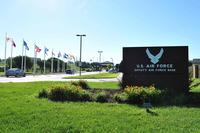The President wants it to happen. The guys on the ground want it to happen. And their bosses in DC want it to happen. But that doesn't mean the bureaucrats are going to let unmanned spy planes start patrolling the southern border. In a speech in El Paso earlier this week, President Bush said he wanted more cash for border patrol technologies, including drones. Border patrol agents -- at least the ones I visited -- thought the robo-planes did a world of good during, when they briefly had them. (And, with millions illegally entering the country every year, these guys could use all the help they can get.)
In a speech in El Paso earlier this week, President Bush said he wanted more cash for border patrol technologies, including drones. Border patrol agents -- at least the ones I visited -- thought the robo-planes did a world of good during, when they briefly had them. (And, with millions illegally entering the country every year, these guys could use all the help they can get.)
U.S. Customs and Border Protection recently bought a new Predator B drone to help its agents out. But that may be the only unmanned aerial vehicle (UAV) the Federal Aviation Administration lets the border guards use, GovExec reports.
After more than two years of negotiations, the Homeland Security Department's U.S. Customs and Border Protection Directorate recently finalized a deal with the FAA to fly one drone in the Tucson, Ariz., area.
CBP also issued an environmental impact study in September that helps clear the way for an expansion of UAV operations from the western corner of Arizona to the eastern corner of Texas, but the agency still needs to work out a deal with the FAA to fly the drones outside restricted military airspace. Because of the restrictions, CBP officials have been forced to deploy a fleet of Blackhawk helicopters to patrol the rest of the southern border.
A CBP spokesman said Wednesday that the agency has recently received the "green light" to buy its second UAV early next year and plans to deploy the drone in the Tucson area until CBP and FAA officials reach additional agreements.
"We have to talk and ask for permission, but FAA is very strict," he said. "We're looking at what we can do to get exemptions" from FAA regulations or maximize the requirements set by FAA for UAVs.
Drone manufacturers, and handlers, have been tangling for years with the FAA over when and where UAVs can fly here at home. Here's a snippet from an article I wrote for the Times three years ago, which to the best of knowledge, is still essentially true:
Jim Brass, a colleague of Mr. Herwitz at the NASA Ames Research Center at Moffett Field, Calif., sought to use a drone last November to look at a forest fire in the San Gabriel Mountains, north of Los Angeles.
But the Federal Aviation Administration refused to let the drone fly. Getting to the fire, a ''controlled burn'' begun by the Forest Service to thin trees, would have involved flying through the approach to the suburban airport in Ontario, Calif., and the F.A.A. did not want a drone in crowded airspace.
It is a common problem for civilian drones. A small, piloted airplane can operate pretty much anywhere with little or no notification. But flying a drone means filing for a certificate of authorization, a narrowly drawn permission slip from the F.A.A. to roam a small strip of the skies. Getting the certificate takes months.
''We aren't pursuing commercial applications over America because U.A.V. flights are so restricted by the F.A.A.,'' Mr. Sliwa said, reflecting a common approach in the industry. The agency has yet to issue minimum standards for the drones' hardware and software. There are no guidelines on how the drones' human operators should be trained.
Okay, obviously you don't want to let pilotless planes roam the skies with no supervision. But, c'mon... it's been three years. It can't be that hard to carve out some space for these drones.









